If you’re struggling with common ice cream problems, you’re not alone. Icy ice cream often stems from large ice crystals, so make certain to chill your mixture and freeze your bowl well. For smoothness, blend the mixture while warm and avoid over-churning. If it’s too soft, check your sugar and fat levels, and guarantee quick freezing. A candy-like taste usually results from low-quality ingredients. To tackle melting issues, aim for higher fat content. There’s more to perfecting your scoop!
Key Takeaways
- Prevent icy texture by freezing the bowl for 24 hours and chilling the mixture thoroughly before churning.
- Avoid lack of smoothness by blending the mixture well while warm and ensuring proper chilling before churning.
- Ensure proper sugar and fat balance to prevent soft ice cream; chill mixture before churning and store immediately in a pre-chilled container.
- Increase air content and adjust sugar balance to avoid dense, hard ice cream; adding corn syrup can also enhance creaminess.
- Use high-quality ingredients and experiment with flavors to prevent a candy-like taste and enhance overall flavor complexity.
My Ice Cream Is Icy

If your ice cream turns out icy, it often means large ice crystals have formed, which can ruin that creamy texture you’re aiming for.
To tackle this problem, guarantee your freezer bowl is frozen for a full 24 hours before use. Chill your ice cream mixture as cold as possible prior to churning; faster freezing results in smaller ice crystals.
Once you’ve churned the mixture, transfer it to the freezer quickly to maintain those small ice crystals and prevent icy ice.
If you’re using high water-content ingredients like strawberries, consider reducing their water through roasting.
Finally, investing in an ice cream maker with a powerful motor will help you avoid iciness, as it freezes mixtures more rapidly.
My Ice Cream Isn’t Smooth
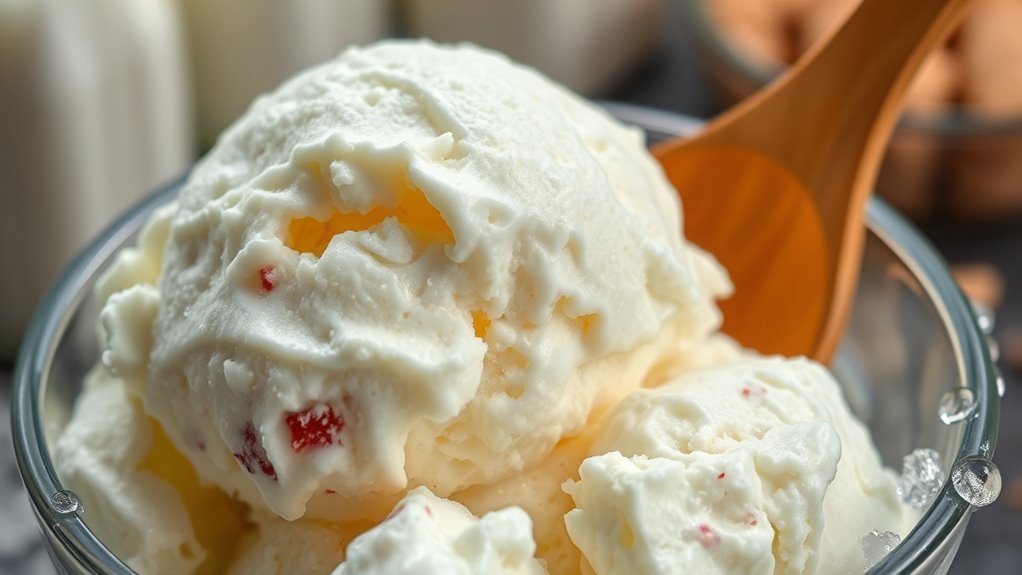
When your ice cream lacks smoothness, it often results from a few key factors that can easily be addressed.
Here are some common issues to take into account:
Here are some common pitfalls to consider for achieving perfectly smooth ice cream.
- Over-emulsification can lead to a gritty texture, so blend your mixture properly while warm.
- Slow freezing can cause large ice crystals, so chill your mixture thoroughly before using ice cream makers.
- Verify the base is well-blended to avoid unpleasant fat globules and don’t over-churn to prevent a butter-like texture.
- High water content from fruits can create iciness, so roast them to concentrate flavors and reduce moisture.
My Ice Cream Is Too Soft

If your ice cream’s too soft, it might be due to recipe imbalances or freezing technique issues.
Check the sugar and fat content in your mixture, as low levels can lead to a softer texture.
Also, make sure your ice cream maker’s bowl is properly frozen and transfer your churned ice cream to the freezer right away for a firmer result.
Recipe Imbalance Issues
A common issue in homemade ice cream is its tendency to be too soft, often stemming from a recipe imbalance.
To create good ice cream with the right texture, consider these factors:
- Excessive free water: Balance with solid ingredients to restrict water movement.
- High sugar content: Aim for a balanced sugar-to-fat ratio to achieve ideal firmness.
- Low-fat dairy products: Use higher-fat creams and whole milk for a firmer structure.
- Chilling the mixture: Allow the ice cream base to cool for at least an hour before churning for better texture.
Freezing Technique Problems
Even with a balanced recipe, your ice cream can still turn out too soft due to freezing technique problems. Insufficient freezing time is often the culprit. Make sure your ice cream maker bowl has been frozen for at least 24 hours. To avoid a soft texture, chill your mixture in the refrigerator for an hour before churning. Domestic machines can struggle, so don’t overload them; churn smaller batches for better results. Quickly transferring your churned ice cream to a pre-chilled container helps maintain smaller ice crystals. If it’s still too soft, consider increasing the sugar slightly to create a creamier texture.
| Problem | Solution |
|---|---|
| Not enough freezing time | Freeze the bowl for 24 hours |
| Mixture too warm | Chill for an hour before churning |
| Overloading the machine | Churn smaller batches |
| Poor texture after churning | Use a pre-chilled container |
| Ice cream is still soft | Adjust sugar content slightly |
My Ice Cream Is Too Hard

When you find your ice cream coming out too hard, it’s often due to a few key factors in your recipe.
Here are some things to take into account:
- Insufficient air content: Low air incorporation can create a dense, icy texture.
- Alcohol addition: Including vodka during churning helps lower the freezing point.
- Sugar balance: Adjusting sugar can inhibit crystallization and maintain a softer consistency.
- Syrups: Using corn syrup can prevent crystallization and enhance creaminess.
Make sure your ice cream machine is set up correctly, and check the balance of fat, sugar, and solids in your mixture.
An improper ratio can lead to rock-hard ice cream.
With these adjustments, you can achieve that perfect scoop!
My Ice Cream Tastes of Candy
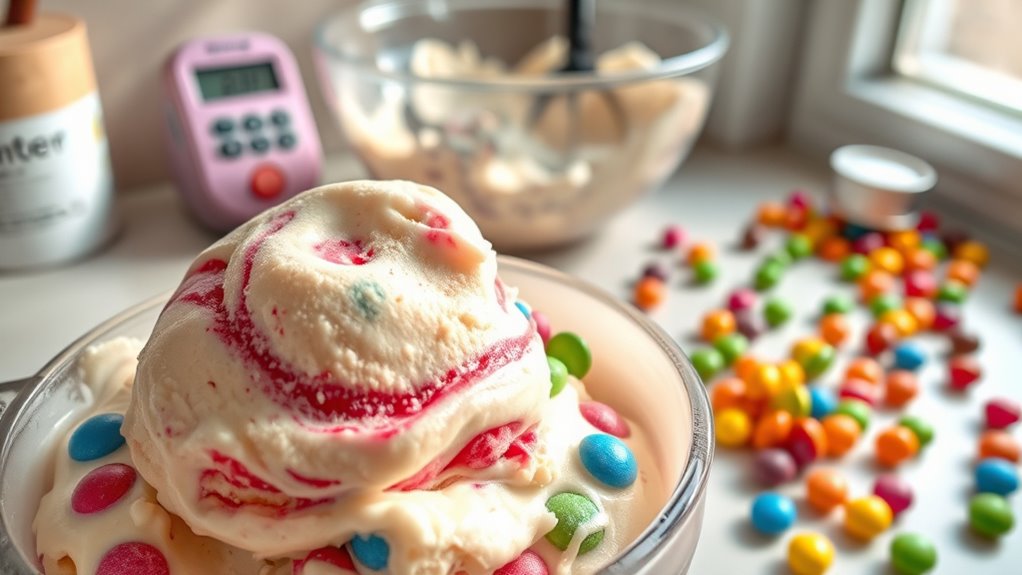
If your ice cream tastes too much like candy, it’s likely due to the quality of your ingredients or the balance of flavors.
Using natural sweeteners and adjusting their ratios can help reduce that overly sweet flavor. A pinch of salt or a splash of lemon juice can also enhance the taste and bring complexity to your ice cream.
Ingredient Quality Matters
Choosing high-quality ingredients is essential for creating delicious homemade ice cream; otherwise, you might find your treat tasting more like candy than creamy indulgence.
Here are some tips to guarantee your ice cream shines:
- Use pure, unadulterated high-fat cream for a rich, satisfying texture.
- Avoid artificial flavorings and cheap additives that can overwhelm natural flavors.
- Opt for fresh fruits with lower water content to concentrate their flavors.
- Be cautious with ingredient substitutions; low-calorie dairy can disrupt the balance of fat and water.
Flavor Balance Techniques
Striking the right flavor balance is key to preventing your ice cream from tasting overly sweet or like candy. Incorporating a higher proportion of cream or milk enhances creaminess, which helps reduce sweetness perception.
A pinch of salt can counteract the sweetness, making your ice cream taste more well-rounded. Opt for natural flavorings like pure vanilla extract or cocoa powder, as they create a complex flavor profile that masks excessive sweetness.
Adding acidity, such as a splash of lemon juice or tart fruits, provides a contrast to sugary notes.
Finally, experiment with mix-ins like nuts or spices to add texture and depth, further diminishing the dominance of candy-like sweetness in your final product. Additionally, consider that high levels of antioxidants in certain ingredients can enhance the overall flavor experience without increasing sweetness.
Adjusting Sweetener Ratios
While balancing flavors is important, the sweetness level can still overpower your ice cream, making it taste more like candy than a delicious treat.
Here are some tips for adjusting sweetener ratios to achieve ideal flavor:
- Use an ice cream calculator to find the right sugar amount based on your recipe volume.
- Experiment with sweeteners like corn syrup, which offers sweetness without a candy-like taste.
- Be mindful of natural sugars in fruits; reduce added sugar to maintain balance.
- Combine sweeteners, such as granulated sugar with honey or maple syrup, for a more complex flavor profile.
Additionally, understanding the average ice cream consumption can help you gauge how sweet your ice cream should be to appeal to a broader audience.
My Ice Cream Tastes Greasy
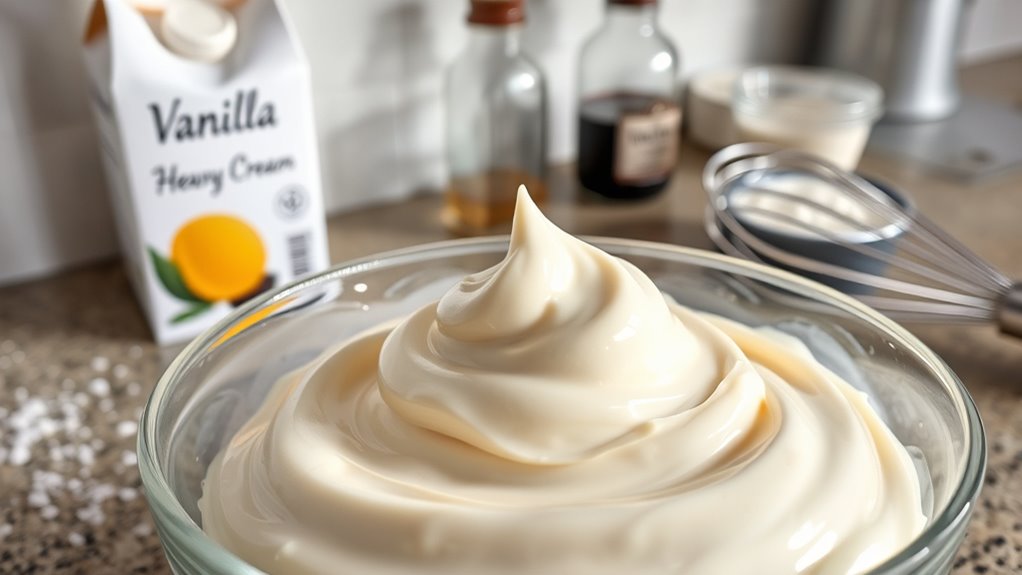
If your ice cream tastes greasy, it might be due to a few common issues during the making process. One major culprit is over-churning, which destabilizes fat globules and leads to an oily mouthfeel.
Using too much butterfat or cream can also contribute to that greasy taste, as excess fat overwhelms the balance needed for smoothness. If your mixture isn’t properly emulsified, fat can clump together, resulting in a greasy sensation.
To avoid this, use an immersion blender for a uniform mixture, and consider aging your ice cream base overnight to enhance emulsification.
Finally, incorporating stabilizers like cornstarch can help bind fat and water more effectively, improving texture and minimizing greasiness.
My Ice Cream Tastes Weak and Watery
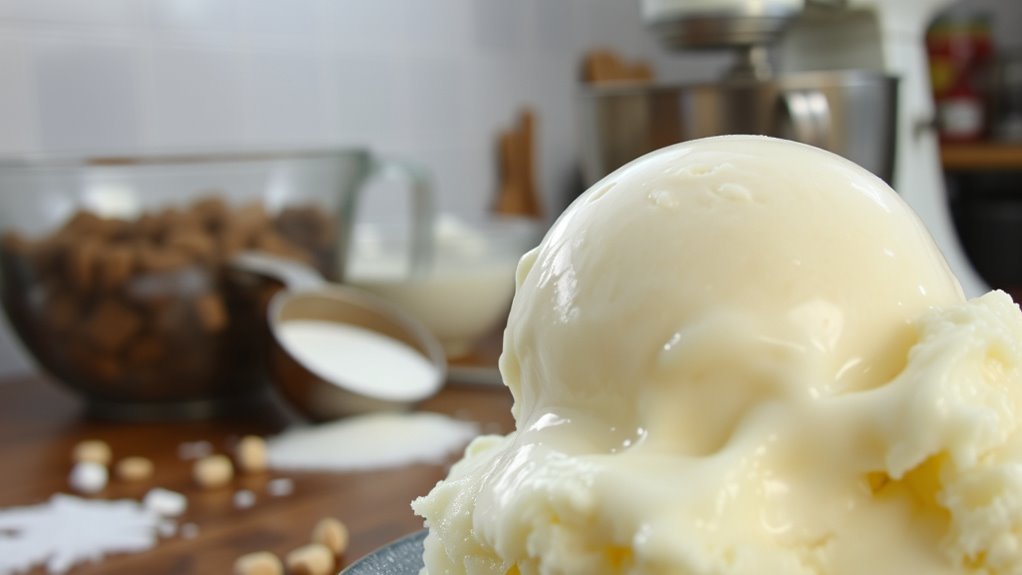
When your ice cream tastes weak and watery, it often stems from unbalanced recipes that include too much water, especially from high-water fruits like strawberries.
To enhance the flavor and improve texture, consider these tips:
- Roast fruits to concentrate their flavor and minimize water content.
- Adjust the sugar-to-fat ratio; higher sugar can boost flavor perception.
- Use high-quality ingredients to avoid a lackluster taste.
- Confirm the ice cream mixture chills thoroughly before churning to promote flavor infusion.
My Ice Cream Melts Too Quickly
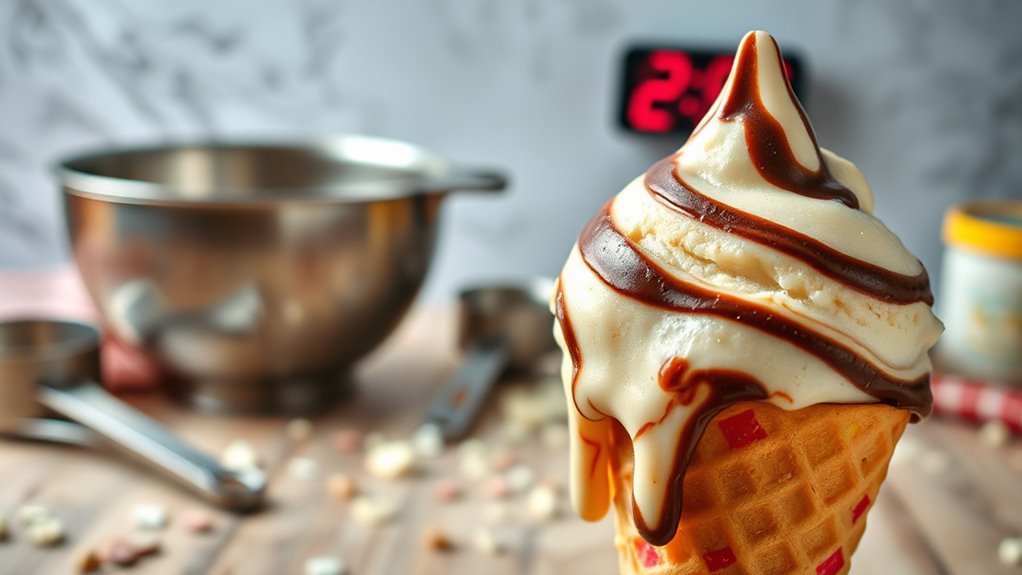
A watery ice cream can lead to rapid melting, making it frustrating to enjoy your homemade treat. If your ice cream melts too quickly, it likely has low fat content, which affects its structure. To improve consistency, try using higher-fat creams or adding stabilizers like cornstarch or gelatin.
Here’s a quick overview of factors affecting melting:
| Factor | Impact on Melting | Solution |
|---|---|---|
| Low Fat Content | Weak structure | Use higher-fat creams |
| High Sugar Content | Lower freezing point | Balance sugar levels |
| Air Content | Less firmness | Optimize air with a calculator |
Finally, store your ice cream at -10°F (-23°C) to maintain its firmness and avoid those frustrating melt moments!
Frequently Asked Questions
Why Is My Ice Cream Maker Not Making Ice Cream?
If your ice cream maker’s not making ice cream, check a few things first.
Make certain the bowl’s frozen for at least 24 hours and that your mixture’s thoroughly chilled before pouring it in.
Confirm the machine’s set to the right mode and the motor’s working properly.
Don’t forget to avoid overfilling it, as that can block the churning.
Finally, if you’ve got a compressor model, verify the compressor’s running continuously during churning.
Why Is My Ice Cream Still Liquid After Churning?
You might find it ironic that your ice cream‘s still liquid after all that effort.
It could be that your ice cream maker’s bowl wasn’t frozen long enough, or maybe your mixture wasn’t chilled properly before churning.
If you’ve used high-water content ingredients or churned for too little time, that’ll keep your ice cream soft.
Finally, low-fat or low-sugar recipes can also lead to a soupy result.
Adjust these factors for a firmer finish!
What Are the Faults in Ice Cream?
When you’re making ice cream, you might encounter faults like icy textures, grainy add-ins, or even a butter-like consistency.
These issues can arise from improper freezing, over-churning, or using hard candies. Additionally, lack of stabilizers may lead to freezer burn, while ingredient swaps can upset the balance of water and fat.
To achieve that creamy, smooth texture you crave, pay attention to your technique and ingredient quality throughout the process.
Why Is My Ice Cream Not Freezing but Everything Else Is?
Imagine a frosty mountain peak, but your ice cream’s still a puddle.
If your ice cream isn’t freezing while everything else is, check if the bowl’s been frozen solid for at least 24 hours.
You’ll want your mixture chilled to the lowest temperature before pouring it in, and avoid overfilling the maker.
Finally, make certain the motor’s running strong and your freezer’s set to the coldest setting.
Conclusion
So, you’ve tackled the common ice cream woes and discovered the secrets to a perfect scoop. But did you know that the type of salt in your ice cream maker can actually impact texture and flavor? Experimenting with different salts might just elevate your homemade creations to gourmet status! Keep refining your technique, and don’t hesitate to get creative with flavors. Your next batch could be the best yet—just a sprinkle of curiosity away from ice cream perfection!










